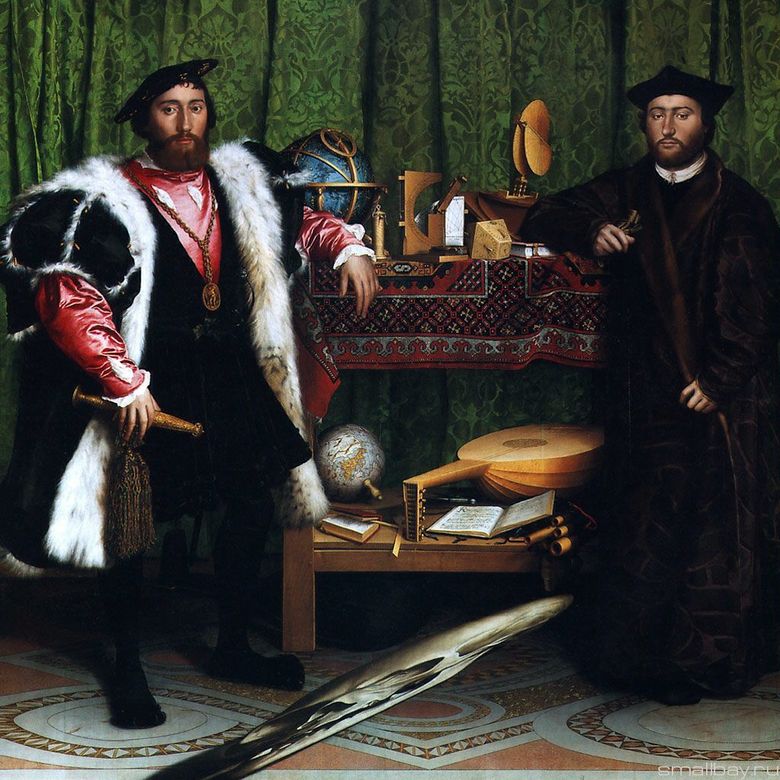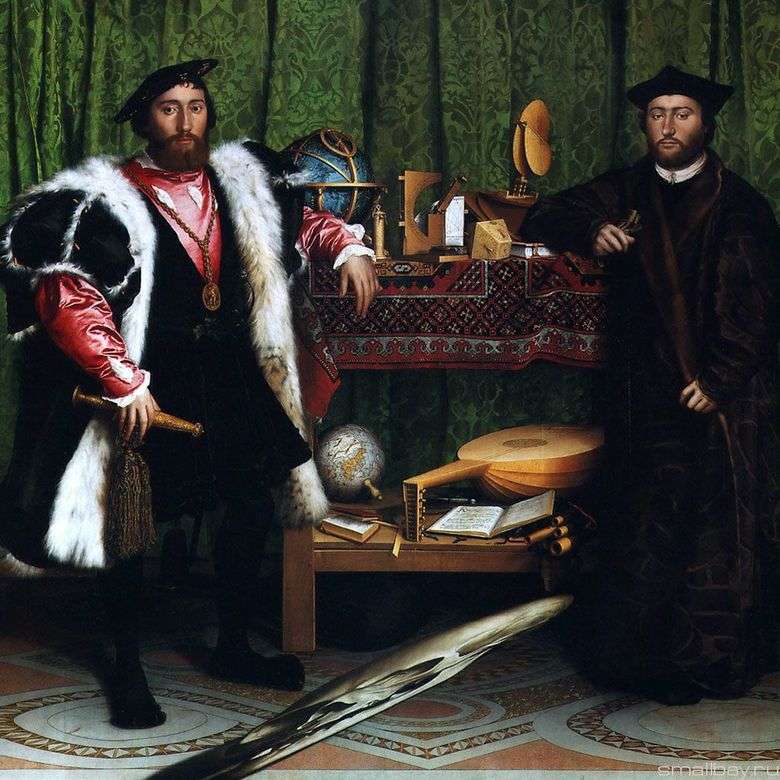
The ceremonial portrait of the French ambassadors Jean de Danteville and Georges de Selva is one of the greatest and most magnificent paintings of Hans Holbein the Younger, created during the heyday of his work. Double portraits were popular with German painters of the Northern Renaissance from the end of the XV century. But for Holbein this canvas is the exception.
Diplomats from France are depicted in natural growth and surrounded by luxurious accessories. In the office lush rich draperies, numerous objects and details emphasizing the intellect of these young, energetic people, their character, tastes and inclinations. Unconstrained poses, without pretentious mannerisms, emphasize dignity. Jean de Danteville and his friend were the heads of the French Embassy in England. Georges de Selva – 24-year-old bishop of Lavursky, was not only a diplomat, but also a scientist, a great lover of music.
Holbein portrayed two people equal in their social status. In those days great importance was attached to this. The artist solved this problem by placing the ambassadors’ figures symmetrically in relation to the center of the composition. And, they do not look at each other, do not contact, and posing in front of the audience, fixing on him penetrating glances. And if you try to divide the picture in two, you will get two independent, equitable portraits.
The only thing the models are related to each other is the color of the picture – an exquisite color scheme that includes dark green, black, pink and deep brown tones. Rich clothes, precious fur and velvet do not suppress their luxury, in this picture nothing says about the high cost of objects, but only about their purpose, they are attributes of sciences and arts, and not wealth as such. The diplomats’ education is emphasized by the headgear worn by graduates of European universities.
The painting was commissioned by the diplomats themselves. Dressed in ceremonial clothes messengers calmly and confidently look at the viewer. Holbein does not go into the inner world of his models – they seem closed, restrained, as befits aristocrats at the court of the king. And yet the artist shows us noble aristocrats educated with diverse interests, where the clergyman is interested in secular sciences, astronomical and geographical instruments. Globe, musical instruments, an open textbook of mathematics – emphasize the familiarity of these young and very educated people with the humanistic ideas of the Renaissance.
 Portrait of the French ambassador in England, Sir Moretta Charles de Soleil by Hans Holbein
Portrait of the French ambassador in England, Sir Moretta Charles de Soleil by Hans Holbein Portrait des ambassadeurs français – Hans Holbein
Portrait des ambassadeurs français – Hans Holbein Portrait of Jacob Mayer by Hans Holbein
Portrait of Jacob Mayer by Hans Holbein Portrait of Boniface of Amerbach by Hans Holbein
Portrait of Boniface of Amerbach by Hans Holbein Portrait of Erasmus of Rotterdam by Hans Holbein
Portrait of Erasmus of Rotterdam by Hans Holbein Retrato de los embajadores franceses – Hans Holbein
Retrato de los embajadores franceses – Hans Holbein Portrait of George Guissé by Hans Holbein
Portrait of George Guissé by Hans Holbein Portrait of Dorothea Cannegisser by Hans Holbein
Portrait of Dorothea Cannegisser by Hans Holbein